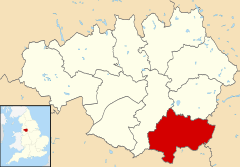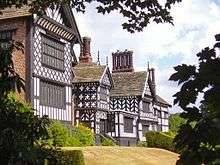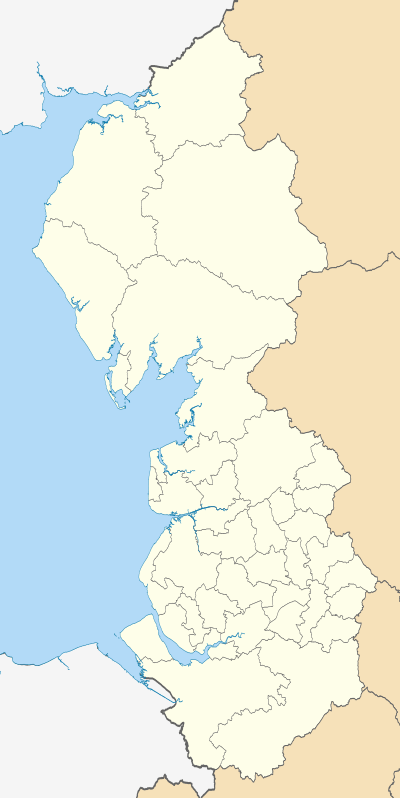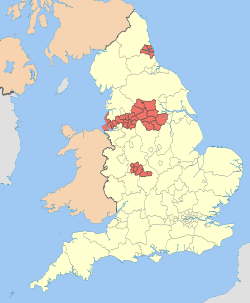Metropolitan Borough of Stockport
The Metropolitan Borough of Stockport is a metropolitan borough of Greater Manchester in North West England. As well as the town of Stockport, it includes the outlying areas of Bramhall, Cheadle, Cheadle Hulme, Marple, Bredbury, Reddish, Woodley and Romiley. In 2001, it had a population of 284,500.[1]
Stockport | |
|---|---|
.jpg) | |
 Coat of arms | |
| Motto(s): "Animo et Fide" "With Courage and Faith" | |
 Stockport shown within Greater Manchester | |
| Coordinates: 53°24′20″N 2°09′33″W | |
| Sovereign state | United Kingdom |
| Constituent country | England |
| Region | North West England |
| Ceremonial county | Greater Manchester |
| Founded | 1 April 1974 |
| Borough status | 23 November 1973 |
| Administrative HQ | Stockport (Town Hall) |
| Government | |
| • Type | Metropolitan borough |
| • Body | Stockport Metropolitan Borough Council |
| • Leadership | Leader and cabinet |
| • Executive | Labour (council NOC) |
| • Leader | Elise Wilson (Labour) |
| • Mayor | Dean Fitzpatrick |
| • MPs | Mary Robinson (C) Andrew Gwynne (L) William Wragg (C) Navendu Mishra (L) |
| Area | |
| • Total | 48.6 sq mi (126.0 km2) |
| Area rank | 196th |
| Elevation | 256 ft (78 m) |
| Population (mid-2019 est.) | |
| • Total | 293,423 |
| • Rank | 44th |
| • Density | 6,000/sq mi (2,315/km2) |
| • Ethnicity (United Kingdom 2005 estimate) | 94.2% White 3.1% S. Asian or mixed 1.4% Black or mixed 1.0% Chinese or other |
| Demonym(s) | Stopfordian |
| Time zone | UTC+0 (Greenwich Mean Time) |
| • Summer (DST) | UTC+1 (British Summer Time) |
| Postcode areas | |
| Dialling codes | 01457 0161 |
| ISO 3166 code | GB-SKP |
| GSS code | E08000007 |
| NUTS 3 code | UKD31 |
| ONS code | 00BS (ONS) |
| OS grid reference | SJ895900 |
| Police area | Greater Manchester |
| Fire service | Greater Manchester |
| Ambulance service | North West |
| Website | www.stockport.gov.uk |
History
The borough was created in 1974, under the Local Government Act 1972, from the former area of the County Borough of Stockport and from the administrative county of Cheshire the urban districts of Bredbury and Romiley, Cheadle and Gatley, Hazel Grove and Bramhall and Marple.
Stockport became a county borough in 1889 and was enlarged by gaining territory from Lancashire, including Reddish in 1906 and the Four Heatons in 1913.[2] The Marple Urban District of Cheshire, formed in 1894, gained parts of Derbyshire in 1936 including Mellor and Ludworth from Chapel en le Frith Rural District.[3]
Prior to its creation, it was suggested that the metropolitan borough be named "Norchester", but this was rejected as "a concocted name", being beaten by "Stockport" by a vote of 16 to 5.[4]
Geography
Governance
Parliamentary constituencies
There are four parliamentary constituencies in the Stockport Metropolitan Borough: Stockport, Cheadle, Hazel Grove, and Denton and Reddish. Stockport has been represented by Navendu Mishra (Labour) since 2019. Mary Robinson (Conservative) has been MP for Cheadle since 2015. William Wragg (Conservative) has been MP for Hazel Grove since 2015. The constituency of Denton and Reddish bridges Stockport and Tameside; the current member is Andrew Gwynne (Labour).
Unparished Areas
Showing former status (prior to 1974), the entire district is unparished (note that Offerton Park, called "Offerton Estate" until 2006, existed from 2002 to 2011):
- Bredbury and Romiley (Urban District)
- Cheadle and Gatley (Urban District)
- Hazel Grove and Bramhall (Urban District)
- Marple (Urban District)
- Stockport (County Borough)
Council
There are 21 electoral wards in Stockport, each with 3 councillors, giving a total of 63 councillors.
From 2002 until 2014, the Liberal Democrats had a controlling majority on the council.[5]
Following the 2014 Local Elections, no party had overall control. The Liberal Democrats remained the largest party, despite losing a seat, but decided not to form a minority administration and strongly refused any possibility of a coalition with the Conservatives.[6]
Following the 2016 Local Elections, no party had overall control with the Liberal Democrat council leader Sue Derbyshire losing her seat and Labour taking over as largest party.[7]
| Party | Seats | Current Council (2019–21) | |||||||||||||||||||||||||||||||||||||||||||||||||||||||||||||||||||
|---|---|---|---|---|---|---|---|---|---|---|---|---|---|---|---|---|---|---|---|---|---|---|---|---|---|---|---|---|---|---|---|---|---|---|---|---|---|---|---|---|---|---|---|---|---|---|---|---|---|---|---|---|---|---|---|---|---|---|---|---|---|---|---|---|---|---|---|---|---|
| 2014[8] | 2015[9] | 2016[7] | 2018[10] | 2019[11] | |||||||||||||||||||||||||||||||||||||||||||||||||||||||||||||||||
| Labour | 22 | 21 | 23 | 24 | 26 | ||||||||||||||||||||||||||||||||||||||||||||||||||||||||||||||||
| Lib Dems | 28 | 26 | 21 | 21 | 26 | ||||||||||||||||||||||||||||||||||||||||||||||||||||||||||||||||
| Conservative | 10 | 13 | 14 | 13 | 8 | ||||||||||||||||||||||||||||||||||||||||||||||||||||||||||||||||
| Heald Green Ratepayers | 3 | 3 | 3 | 3 | 3 | ||||||||||||||||||||||||||||||||||||||||||||||||||||||||||||||||
| Independent | 0 | 0 | 2 | 0 | 0 | ||||||||||||||||||||||||||||||||||||||||||||||||||||||||||||||||
Demography
| Stockport Compared | |||
|---|---|---|---|
| 2001 UK Census | Stockport | Greater Manchester | England |
| Total population | 284,528 | 2,514,757 | 49,138,831 |
| White | 95.7% | 91.2% | 90.9% |
| Asian | 2.1% | 5.6% | 4.6% |
| Black | 0.4% | 1.2% | 2.3% |
At the 2001 UK census, the Metropolitan Borough of Stockport had a total population of 284,528.[12] Of the 120,456 households in Stockport: 38.0% were married couples living together, 30.3% were one-person households, 8.3% were co-habiting couples and 9.4% were lone parents.[13]
The population density is 2,257/km2 (5,850/sq mi)[14] and, for every 100 females, there were 93.2 males. Of those aged 16–74 in Stockport, 25.7% had no academic qualifications, lower than 28.9% in all of England.[12] 5.0% of Stockport's residents were born outside the United Kingdom, significantly lower than the national average of 9.2%.[15] The largest minority group was recorded as Asian, at 2.1% of the population.[16]
Population change
The table below details the population change since 1801, including the percentage change since the last available census data. Although the Metropolitan Borough of Stockport has only existed 1974, figures have been generated by combining data from the towns, villages and civil parishes that would later be constituent parts of the borough.
| Population growth in Stockport since 1801 | |||||||||||||||||||||
|---|---|---|---|---|---|---|---|---|---|---|---|---|---|---|---|---|---|---|---|---|---|
| Year | 1801 | 1811 | 1821 | 1831 | 1841 | 1851 | 1861 | 1871 | 1881 | 1891 | |||||||||||
| Population | 18,901 | 23,957 | 29,745 | 39,027 | 50,340 | 51,232 | 67,034 | 82,837 | 98,693 | 114,252 | |||||||||||
| % change | – | +26.7 | +24.3 | +31.2 | +29.0 | +1.8 | +30.8 | +23.6 | +19.1 | +15.8 | |||||||||||
| Source: Vision of Britain[17] | |||||||||||||||||||||
| Population growth in Stockport since 1801 | |||||||||||||||||||||
|---|---|---|---|---|---|---|---|---|---|---|---|---|---|---|---|---|---|---|---|---|---|
| Year | 1901 | 1911 | 1921 | 1931 | 1941 | 1951 | 1961 | 1971 | 1981 | 1991 | |||||||||||
| Population | 135,156 | 159,884 | 172,025 | 185,087 | 204,265 | 225,433 | 256,848 | 292,695 | 288,977 | 288,354 | |||||||||||
| % change | +18.3 | +18.3 | +7.6 | +7.6 | +10.4 | +10.4 | +13.9 | +14.0 | −1.3 | −0.2 | |||||||||||
| Source: Vision of Britain[17] | |||||||||||||||||||||
| Population growth in Stockport since 1801 | |||||||||||||||||||||
|---|---|---|---|---|---|---|---|---|---|---|---|---|---|---|---|---|---|---|---|---|---|
| Year | 2001 | 2011 | 2021 | 2031 | 2041 | 2051 | 2061 | 2071 | 2081 | 2091 | |||||||||||
| Population | 284,544 | 283,300 | |||||||||||||||||||
| % change | −1.3 | −0.4 | |||||||||||||||||||
| Source: Vision of Britain[17] | |||||||||||||||||||||
Economy
| Stockport Compared | |||
|---|---|---|---|
| 2011 UK Census[18] | Stockport | North West England | England |
| Population of working age | 178,400 | 4,839,669 | 35,532,091 |
| Full-time employment | 43.3% | 38.8% | 40.8% |
| Part-time employment | 12.5% | 11.9% | 11.8% |
| Self employed | 8.4% | 7.1% | 8.3% |
| Unemployed | 2.5% | 3.6% | 3.3% |
| Retired | 14.8% | 14.3% | 13.5% |

The Co-operative Bank opened a telephone banking centre in the Stockport pyramid in 1994.[19] In 1999, the Stockport pyramid became the administrative home of smile.co.uk, an internet bank owned by the Co-op. The Co-op moved out of the pyramid building in 2019 and it is now available to let. Experian ranked Stockport fifth in North West England for shopping. The Merseyway Shopping Centre underwent a £15m redevelopment.[20] Other shopping centres in Stockport include the Grand Central Stockport and the Stockport Peel Centre.
Medical equipment and technology, financial and professional services, computer and internet based services, and creative industries have been identified as growth industries in Greater Manchester, all with concentrations in Stockport. With employment at 2.0%, Stockport has the lowest rate of unemployment of all Greater Manchester's boroughs.[21] Average house prices in the Stockport are second out of all the metropolitan boroughs in Greater Manchester, 27.7% higher than the average for the county.[22]
At the 2001 UK census, Stockport had 204,812 residents aged 16 to 74. 2.4% of these people were students with jobs, 3.3% students without jobs, 5.4% looking after home or family, 5.0% permanently sick or disabled and 2.4% economically inactive for other reasons. These figures were generally in line with the national averages, although the proportion of people looking after home and family and students without jobs was significantly lower than the national average.[23]
In 2001, of 136,059 residents of Stockport in employment, the industry of employment was: 17.3% retail and wholesale, 14.7% manufacturing, 13.8% property and business services, 11.7% health and social work, 8.9% education, 7.7% transport and communications, 6.1% construction, 5.3% finance, 4.6% public administration and defence, 4.1% hotels and restaurants, 0.7% energy and water supply, 0.6% agriculture and 4.3% other. This was roughly in line with national figures, except for the proportion of jobs in agriculture which is less than half the national average, reflecting the town's suburban nature and its proximity to the centre of Manchester.[24]
Landmarks

Stockport has 386 listed buildings.[25]
There are six Scheduled Ancient Monuments in the borough. Two date to the Bronze Age, a cairn in Ludworth and the Brown Low bowl barrow.[26][27] Two related to medieval halls, Peel Hall in Heaton Moor and Torkington Moat.[28][29] The final two were both built at the start of the 19th century, Oldknows Limekilns and the Marple Aqueduct.[30][31]
Stockport has 14 local nature reserves: Abney Hall Park, Carr Wood, Chadkirk Country Estate, Crookilley Woods, Etherow Country Park, Gatley Carrs, Heaton Mersey Common, Happy Valley, Mersey Vale Nature Park, Poise Brook, Reddish Vale Country Park, Tangshutts Fields, Woodbank Park and Wright's Wood.[32]
Education
Overall, Stockport was ranked 21st out of the all the Local Education Authorities in SATs performance in 2006 and was 2nd in Greater Manchester.[33] Authorised and unauthorised absences from Stockport secondary schools in 2006-07 were 6.7% and 1.3% respectively, almost the same as the national average (6.8% and 1.3%).[34] In 2007, the Stockport LEA was ranked 30th out of 148 in the country, and 2nd in Greater Manchester, based on the percentage of pupils attaining at least 5 A*-C grades at GCSE including Maths and English (50.0% compared with the national average of 45.8%).[35]
In 2006, Cheadle Hulme School was the most successful school in Stockport at both GCSE and A-level; 99% of the pupils gaining five or more GCSEs at A*-C grade including Maths and English. At A-level, it was also the 72nd most successful school in the country.[36][37]
Twin towns
The Borough of Stockport has formal twinning arrangements with two European places:[38] Béziers was originally twinned with the County Borough of Stockport and became twinned with the Metropolitan Borough on its creation in 1974.[39]
| Country | Place | County / District / Region / State | Originally twinned with | Date | |||
|---|---|---|---|---|---|---|---|
| France | Béziers | Languedoc-Roussillon | County Borough of Stockport | 1972 | |||
| Germany | Heilbronn | Baden-Württemberg | Metropolitan Borough of Stockport | 1982 |
References
- "Census 2001 Key Statistics – Urban area summary results for local authorities KS01 Usual resident population". Statistics.gov.uk. Retrieved 13 February 2012.
- Vision of Britain Archived 27 September 2007 at Archive.today - Heaton Norris UD
- Vision of Britain Archived 30 March 2007 at the Wayback Machine - Marple Urban District
- Clark 1973, p. 101..
- "BBC NEWS, Election 2006, Stockport". BBC News. Retrieved 12 May 2010.
- "Stockport becomes hung council after Lib Dem losses, Election 2011". BBC News. Retrieved 6 October 2011.
- "2016 May Elections in the Granada region: Labour takes control of Stockport from Liberal Democrats". ITV News. ITN. 6 May 2016. Retrieved 15 June 2016.
- "Local Election 2014 - Thursday, 22nd May, 2014". democracy.stockport.gov.uk. Stockport MBC. 22 May 2014. Archived from the original on 11 August 2016. Retrieved 15 June 2016.
- "Local Election 2015 - Thursday, 7th May, 2015". democracy.stockport.gov.uk. Stockport MBC. 22 May 2014. Retrieved 15 June 2016.
- http://democracy.stockport.gov.uk/mgElectionResults.aspx?ID=48&RPID=0
- https://www.stockport.gov.uk/news/local-elections-results-2019
- "Stockport Metropolitan Borough key statistics". Statistics.gov.uk. Retrieved 21 December 2007.
- "Stockport Metropolitan Borough household data". Statistics.gov.uk. Retrieved 21 December 2007.
- "Stockport Metropolitan Borough population density". Statistics.gov.uk. Retrieved 21 December 2007.
- "Stockport Metropolitan Borough country of birth data". Statistics.gov.uk. Retrieved 21 December 2007.
- "Stockport Metropolitan Borough ethnic group data". Statistics.gov.uk. Retrieved 21 December 2007.
- "Stockport District: total population". Vision of Britain. Retrieved 20 December 2008.
- "Archived copy". Archived from the original on 3 September 2014. Retrieved 28 August 2014.CS1 maint: archived copy as title (link)
- "The best laid plans have aft gang aglay". Stockport Express. December 1999. Retrieved 2 July 2008.
- "Economic overview". Stockport.gov.uk. Archived from the original on 13 March 2008. Retrieved 2 July 2008.
- "Promoting a Dynamic Economy". Greater Manchester e-Government Partnership. Archived from the original on 12 January 2008. Retrieved 12 April 2008.
- "House prices for Greater Manchester Local Authorities". BBC News Online. Retrieved 2 July 2008.
- "Stockport Local Authority economic activity". Statistics.gov.uk. Retrieved 2 July 2008.
- "Stockport Local Authority industry of employment". Statistics.gov.uk. Retrieved 2 July 2008.
- "Listed Buildings". Stockport Metropolitan Borough Council. Retrieved 13 February 2012.
- Historic England. "Bronze Age cairn in Ludworth (890910)". PastScape. Retrieved 4 January 2008.
- Historic England. "Brown Low (78554)". PastScape. Retrieved 4 January 2008.
- Historic England. "Peel Hall, Stockport (76845)". PastScape. Retrieved 4 January 2008.
- Historic England. "Torkington Moat (78351)". PastScape. Retrieved 4 January 2008.
- Historic England. "Oldknows Limekilns (78346)". PastScape. Retrieved 30 December 2007.
- Historic England. "Marple Goyt Aqueduct (78557)". PastScape. Retrieved 30 December 2007.
- "Local Nature Reserves". Stockport Metropolitan Borough Council. Retrieved 13 February 2012.
- "LEA SATs performance". BBC Online. 7 December 2006. Retrieved 18 December 2007.
- "Stockport schools". BBC Online. 11 January 2007. Retrieved 26 December 2007.
- "How different LEAs performed". BBC Online. 17 January 2007. Retrieved 18 December 2007.
- "Education results in Stockport". BBC Online. 11 January 2007. Retrieved 26 December 2007.
- "Top A-level results". BBC Online. 11 January 2007. Retrieved 18 December 2007.
- "Twin Towns and Link Areas". Stockport.gov.uk. Archived from the original on 18 June 2012. Retrieved 13 February 2012.
- "British towns twinned with French towns". Archant Community Media Ltd. Retrieved 11 July 2013.
Bibliography
- Clark, David M. (1973). "Greater Manchester Votes: A Guide to the New Metropolitan Authorities". Redrose. Cite journal requires
|journal=(help)CS1 maint: ref=harv (link)

